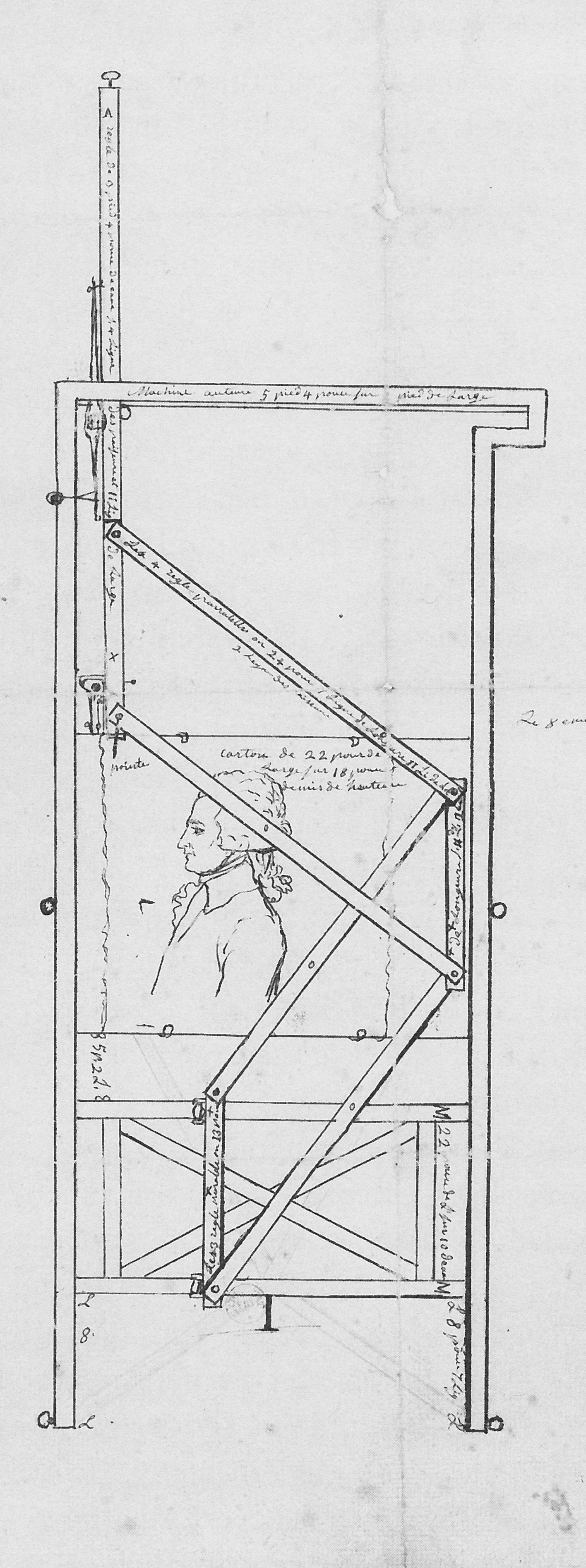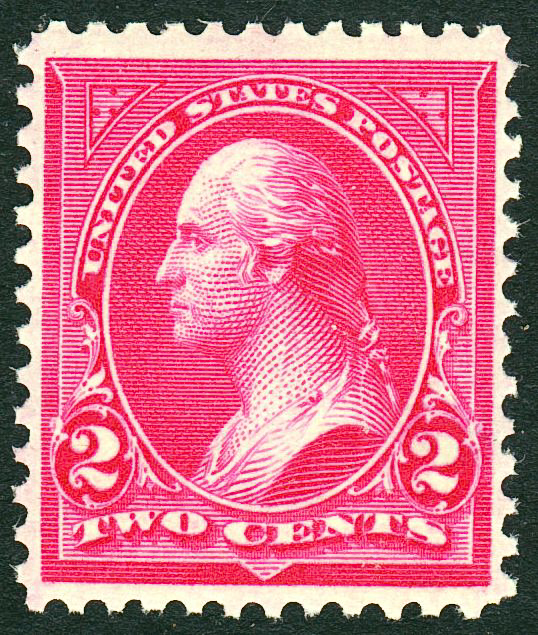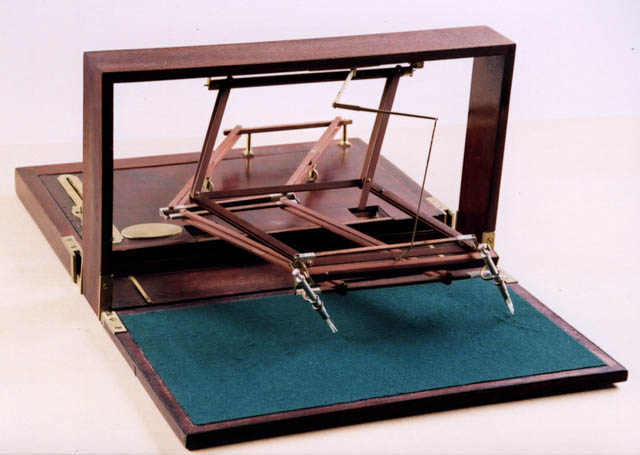|
Physiognotrace
A physiognotrace is an instrument, designed to trace a person's physiognomy to make semi-automated portrait aquatints. Invented in France in 1783–1784, it was popular for some decades. The sitter climbed into a wooden frame (1.75m high x 0.65m wide), sat and turned to the side to pose. A pantograph connected to a pencil produced within a few minutes a "grand trait", a contour line on a piece of paper. With the help of a second scaling-down pantograph, the basic features of the portrait were transferred from the sheet in the form of dotted lines to a copper plate, which had previously been prepared with a ground for etching. One week later, the sitter received an etched plate and twelve little prints. The device but also the aquatint prints are called physionotraces. History In 1783–1784, the Frenchman Gilles-Louis Chrétien invented the "physionotrace" to aid in the production of silhouette portraits, which became popular during the reign of Louis XVI. Within a few minutes, ... [...More Info...] [...Related Items...] OR: [Wikipedia] [Google] [Baidu] |
Charles Willson Peale
Charles Willson Peale (April 15, 1741 – February 22, 1827) was an American Painting, painter, soldier, scientist, inventor, politician and naturalist. He is best remembered for his portrait paintings of leading figures of the American Revolution, and for establishing one of the first museums in the United States. Early life Peale was born in 1741 between modern-day Queenstown, Maryland, Queenstown and Centreville, Maryland, Centreville, Queen Anne's County, Maryland, the son of Charles Peale (1709–1750) and his wife Margaret Triggs (1709–1791). He had a younger brother, James Peale (1749–1831). He was the brother-in-law of Nathaniel Ramsey, a delegate to the Congress of the Confederation. Four years after his father’s death in 1750, Charles became an apprentice to a saddle maker by the name of Nathan Waters when he was thirteen years old. Upon reaching maturity, he opened his own saddle shop and joined the Sons of Liberty in 1764 in opposition to the “court” pa ... [...More Info...] [...Related Items...] OR: [Wikipedia] [Google] [Baidu] |
Charles Balthazar Julien Févret De Saint-Mémin
Charles Balthazar Julien Févret de Saint-Mémin (1770–1852) was a French portrait painter and museum director. He left France during the Revolution, and worked as a portrait engraver in the United States in the early 19th century. He created portraits from life of George Washington, Thomas Jefferson, and others. He later served as museum director in Dijon. Brief history Born in France in 1770 to Benigne Charles Fevret and Victoire Marie de Motmans, Saint-Memin was educated at École Militaire, Paris, graduating in 1785. In 1788 he served in the French Guards. During the French Revolution, Saint-Memin and his family travelled to Switzerland, and then in 1793 to New York City. They intended to go to Saint-Domingue, ”to prevent the sequestration of the lands of his creole mother oweverin New York news of the sad fate of that colony made them decide to remain where they were. Faced with earning a living, they first tried raising vegetables, but ... this experiment proved in ... [...More Info...] [...Related Items...] OR: [Wikipedia] [Google] [Baidu] |
James Sharples
James Sharples (1751 or 1752, in Lancashire – 26 February 1811, in New York City) was an English portrait painter and pastelist, who moved to the United States in 1794. He first exhibited at the Royal Academy in 1779. Life James was first intended for the Catholic priesthood, but became an artist instead. Sharples headed a family of successful portrait artists, including his third wife Ellen Sharples. He had four children: George by his first wife; Felix Thomas Sharples from his second marriage (c. 1786- after 1823); and James Sharples Jr.(c. 1788–1839) and daughter Rolinda Sharples (1793–1838) with this third wife, Ellen. Felix, James Jr. and Rolinda joined the family enterprise at ages 17, 15, and 13 respectively. Before marrying Ellen Wallace, James had been active in Bristol, Liverpool and Bath, where he taught drawing. The family left for the United States in 1796, but, according to Ellen's diaries, their ship fell into the hands of the French, and for seven mon ... [...More Info...] [...Related Items...] OR: [Wikipedia] [Google] [Baidu] |
John Isaac Hawkins
John Isaac Hawkins (1772–1855) was an inventor who practised civil engineering. He was known as the co-inventor of the ever-pointed pencil, an early mechanical pencil, and of the upright piano. Early life Hawkins was born 14 March 1772 at Taunton, Somerset, England,R. L. Tafel, ''Documents Concerning Swedenborg'', p. 1217 the son of Joan Wilmington and her husband Isaac Hawkins, a watchmaker. The father, Isaac Hawkins, would become a Wesleyan minister, but was expelled by John Wesley; and after moving the family to Moorfields in London he was a minister in the Swedenborgian movement, which John Isaac would also follow. John Isaac emigrated to the United States about 1790, attending the College of New Jersey, where he studied medicine and later, chemical filtration. Hawkins married in New Jersey, and was living at Bordentown and Philadelphia. In his own account, he was influenced by work of Georg Moritz Lowitz to try charcoal for filtration purposes, and ran an exhibition on ... [...More Info...] [...Related Items...] OR: [Wikipedia] [Google] [Baidu] |
Pierre Gaveaux By Edmé Quenedey (1821)
Pierre is a masculine given name. It is a French language, French form of the name Peter (given name), Peter. Pierre originally meant "rock" or "stone" in French (derived from the Greek word πέτρος (''petros'') meaning "stone, rock", via Latin "petra"). It is a translation of Aramaic כיפא (''Kefa),'' the nickname Jesus gave to apostle Saint Peter, Simon Bar-Jona, referred in English as Saint Peter. Pierre is also found as a surname. People with the given name * Abbé Pierre, Henri Marie Joseph Grouès (1912–2007), French Catholic priest who founded the Emmaus Movement * Monsieur Pierre, Pierre Jean Philippe Zurcher-Margolle (c. 1890–1963), French ballroom dancer and dance teacher * Pierre (footballer), Lucas Pierre Santos Oliveira (born 1982), Brazilian footballer * Pierre, Baron of Beauvau (c. 1380–1453) * Pierre, Duke of Penthièvre (1845–1919) * Pierre, marquis de Fayet (died 1737), French naval commander and Governor General of Saint-Domingue * Prince Pier ... [...More Info...] [...Related Items...] OR: [Wikipedia] [Google] [Baidu] |
James Madison
James Madison Jr. (March 16, 1751June 28, 1836) was an American statesman, diplomat, and Founding Father. He served as the fourth president of the United States from 1809 to 1817. Madison is hailed as the "Father of the Constitution" for his pivotal role in drafting and promoting the Constitution of the United States and the Bill of Rights. Madison was born into a prominent slave-owning planter family in Virginia. He served as a member of the Virginia House of Delegates and the Continental Congress during and after the American Revolutionary War. Unsatisfied with the weak national government established by the Articles of Confederation, he helped organize the Constitutional Convention, which produced a new constitution. Madison's Virginia Plan was the basis for the Convention's deliberations, and he was an influential voice at the convention. He became one of the leaders in the movement to ratify the Constitution, and joined Alexander Hamilton and John Jay in writing '' ... [...More Info...] [...Related Items...] OR: [Wikipedia] [Google] [Baidu] |
Dolly Madison
Dolly Madison is an American bakery brand owned by Hostess Brands, selling packaged baked snack foods. It is best known for its long marketing association with the ''Peanuts'' animated TV specials. History In 1937, Ralph Leroy Nafziger started a snack cake brand in Georgia called Dolly Madison. The name was inspired by first lady Dolley Madison known for elegant parties. The brand's slogan was "Cakes and pastries fine enough to serve at the White House." Although a Dolly Madison Bakery appears in the 1932 movie '' Officer 13'' and was named after Dolley Madison, the wife of President James Madison, although with the first name spelled differently. The name was used for a successful ice cream brand sold for decades in the United States in the mid-twentieth century. The logo featured a silhouette of Dolly Madison. This brand was among the products that were liquidated by Hostess due to its announced plans to go out of business on November 16, 2012. Apollo Global Management, who a ... [...More Info...] [...Related Items...] OR: [Wikipedia] [Google] [Baidu] |
George Washington
George Washington (February 22, 1732, 1799) was an American military officer, statesman, and Founding Father who served as the first president of the United States from 1789 to 1797. Appointed by the Continental Congress as commander of the Continental Army, Washington led the Patriot forces to victory in the American Revolutionary War and served as the president of the Constitutional Convention of 1787, which created the Constitution of the United States and the American federal government. Washington has been called the " Father of his Country" for his manifold leadership in the formative days of the country. Washington's first public office was serving as the official surveyor of Culpeper County, Virginia, from 1749 to 1750. Subsequently, he received his first military training (as well as a command with the Virginia Regiment) during the French and Indian War. He was later elected to the Virginia House of Burgesses and was named a delegate to the Continental Congress ... [...More Info...] [...Related Items...] OR: [Wikipedia] [Google] [Baidu] |
Polygraph (duplicating Device)
A Polygraph is a duplicating device that produces a copy of a piece of writing simultaneously with the creation of the original, using pens and ink. Patented by John Isaac Hawkins on May 17, 1803, it was most famously used by the third U.S. president, Thomas Jefferson, who acquired his first polygraph in 1804 and later suggested improvements to Charles Willson Peale, owner of the American rights. . Because Jefferson was a prolific letter writer, the preservation of his copies have offered historians extensive insights into Jefferson's viewpoints and actions. Jefferson called the polygraph "the finest invention of the present age". A description of Jefferson's office routine in his own words may be read online. Another American, Benjamin Henry Latrobe was the first customer of Peale's and not only introduced the device to Jefferson but was also instrumental in its improvement. Mechanisms of this type are more generally known as pantographs, which include simple devices for m ... [...More Info...] [...Related Items...] OR: [Wikipedia] [Google] [Baidu] |
William Thornton
William Thornton (May 20, 1759 – March 28, 1828) was a British-American physician, inventor, painter and architect who designed the United States Capitol. He also served as the first Architect of the Capitol and first Superintendent of the United States Patent Office. Early life From an early age William Thornton displayed interest and discernible talent in "the arts of design," to employ an 18th-century term that is particularly useful in assessing his career. Thornton was born on Jost Van Dyke in the British Virgin Islands, West Indies, in a Quaker community.Frary (1969), p. 29 where he was heir to sugar plantations. He was sent to England at age five to be educated. Frary Thornton was brought up strictly by his father's relations, Quakers and merchants, in and near the ancient castle town of Lancaster, in northern Lancashire, England. There was never any question of his pursuing the fine arts professionally—he was to be trained for a useful life, according to the Q ... [...More Info...] [...Related Items...] OR: [Wikipedia] [Google] [Baidu] |
Library Of Congress
The Library of Congress (LOC) is the research library that officially serves the United States Congress and is the ''de facto'' national library of the United States. It is the oldest federal cultural institution in the country. The library is housed in three buildings on Capitol Hill in Washington, D.C.; it also maintains a conservation center in Culpeper, Virginia. The library's functions are overseen by the Librarian of Congress, and its buildings are maintained by the Architect of the Capitol. The Library of Congress is one of the largest libraries in the world. Its "collections are universal, not limited by subject, format, or national boundary, and include research materials from all parts of the world and in more than 470 languages." Congress moved to Washington, D.C., in 1800 after holding sessions for eleven years in the temporary national capitals in New York City and Philadelphia. In both cities, members of the U.S. Congress had access to the sizable collection ... [...More Info...] [...Related Items...] OR: [Wikipedia] [Google] [Baidu] |
Thomas Jefferson
Thomas Jefferson (April 13, 1743 – July 4, 1826) was an American statesman, diplomat, lawyer, architect, philosopher, and Founding Fathers of the United States, Founding Father who served as the third president of the United States from 1801 to 1809. He was previously the nation's second vice president of the United States, vice president under John Adams and the first United States Secretary of State, United States secretary of state under George Washington. The principal author of the United States Declaration of Independence, Declaration of Independence, Jefferson was a proponent of democracy, republicanism, and individual rights, motivating Thirteen Colonies, American colonists to break from the Kingdom of Great Britain and form a new nation. He produced formative documents and decisions at state, national, and international levels. During the American Revolution, Jefferson represented Virginia in the Continental Congress that adopted the Declaration of Independence. As ... [...More Info...] [...Related Items...] OR: [Wikipedia] [Google] [Baidu] |









